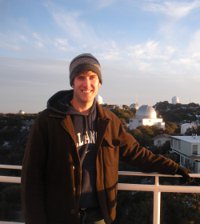Robert Zellem

Address:
4800 Oak Grove Drive
M/S 169-237
Curriculum Vitae:
Click hereMember of:
Exoplanet Discovery and ScienceBiography
Rob is an exoplanet astronomer at NASA’s Jet Propulsion Laboratory working on ground- and space-based observations of the atmospheres of exoplanets, planets outside of our Solar System. Rob is a member of the Nancy Grace Roman Space Telescope's Coronograph Instrument (CGI; an instrument that will directly-image exoplanets) Project Science Team and is the lead of developing its Science Calibration Plan. He is the JPL Commissioning Lead of NESSI, a new multi-object spectrograph at Palomar Observatory that will study tens of these alien worlds. He has been involved in benchmarking the performance through simulations of NASA and ESA exoplanet-dedicated missions such as CASE, the NASA contribution to ESA's ARIEL mission, and the Astro2020 missions Origins Space Telescope and HabEx. He is also the Project Lead of Exoplanet Watch, a citizen science project that will aid in the characterization of exoplanets.
Rob was born just outside the Philadelphia city limits but grew up in Hendersonville, TN. He went to Villanova University where he graduated with his Bachelor of Science in Astronomy and Astrophysics, minoring in Physics, Mathematics, and Classics, and getting an Honors Concentration. His love of travel and learning about other cultures brought him to University College London in England where he got his MSc in Space Science. He then moved out west to Tucson, AZ, where he received his PhD in Planetary Sciences from the Lunar and Planetary Laboratory at the University of Arizona. He is currently staff at NASA’s Jet Propulsion Laboratory. When he's not observing exoplanets, he enjoys jazz piano, cooking, trying not to kill all his plants, brewing beer, playing ice hockey, and fantasizing about retiring to work at Disney.
Education
- PhD in Planetary Science – Lunar & Planetary Laboratory – University of Arizona
- MSc with Distinction in Space Science – University College London
- BS in Astronomy & Astrophysics – Villanova University
Professional Experience
Data reduction and analysis (proficient in Python3; experience in MATLAB, IDL, Fortran, and C/C++) design reference mission experience, instrument commissioning, ground-based observing, has served as lead on multiple projects
Community Service
Regularly gives public talks on research; volunteer at Pasadena Heritage
Research Interests
Measure the atmospheric molecular abundances and thermal structures of exoplanets via the transit and direct imaging methods; mission design and development
Selected Awards
- NASA Group Achievement Award to Astrophysics Large Mission Study Team 2019
- JPL Team Award for contributions to the CASE Step 2 Core Proposal Team 2019
- JPL Team Award in recognition for modification and demonstration of the NESSI instrument for use at Mt. Palomar, and the resulting scientific observations 2019
- JPL Team Award for helping develop the EXCALIBUR science pipeline 2018
- JPL Astronomy & Physics Directorate Special Thanks & Recognition (STAR) Award 2017
Selected Publications
Zellem, R.; et al. (2020), Using Small Telescopes Operated by Citizen Scientists for Transiting Exoplanet Follow-up, PASP, 132, 054401
Zellem, R.; et al. (2019), Constraining Exoplanet Metallicities and Aerosols with ARIEL: An Independent Study by the Contribution to ARIEL Spectroscopy of Exoplanets (CASE) Team, PASP, 131, 094401
Zellem, R.; et al. (2019), Engaging Citizen Scientists to Keep Transit Times Fresh and Ensure the Efficient Use of Transiting Exoplanet Characterization Missions, submitted as an Astro2020 Science White Paper
Zellem, R.; et al. (2018) Additional Exoplanet Science Enabled by FINESSE, submitted as National Academy White Paper
Zellem, R.; et al. (2017) Forecasting the Impact of Stellar Activity on Transiting Exoplanet Spectra, ApJ, 844, 27
Zellem, R.; et al. (2015) XO-2b: A Hot Jupiter with a Variable Host Star That Potentially Affects Its Measured Transit Depth, ApJ, 810, 11